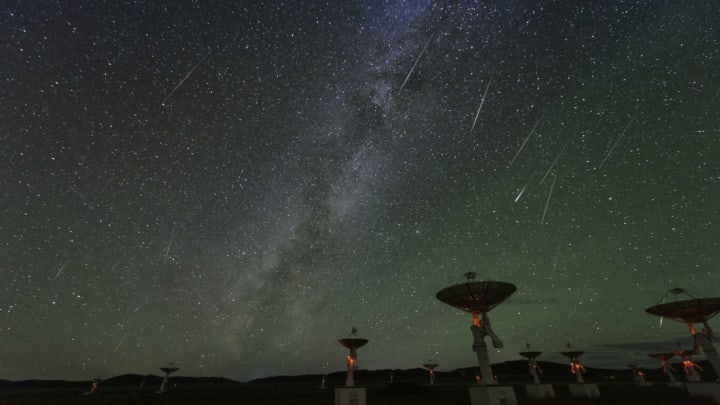February isn't the most active month of the year for skywatching, but depending on your location, there are definitely a few wonders in the sky worth making time for. From meteor showers to a beating heart in space, here are the best celestial shows to be seen on February nights.
FEBRUARY 7–8: ALPHA CENTAURID METEORS
If you live in the Southern Hemisphere, just after midnight leading into February 8, you might be in for a treat: the Centaurids meteor shower will peak, bringing with it a handful of shooting stars per hour. This isn't a major meteor shower, so if you really want to see the good stuff, you're going to need to find an area of little-to-no light pollution, and give your eyes a good hour to adjust to the darkness. (Turn off your phone; no one is going to call you at that hour anyway, and your smartphone camera isn't going to see a thing.)
The origin of the meteors is a bit of a mystery. We know the meteors are caused by the Earth slamming into the trail of debris left behind by a comet—but we don't know which comet. On the upside, we're well aware that the meteors appear to originate in the constellation Centaurus, which means you can find them in the sky. If you are familiar with the "Southern Cross," the most famous of that hemisphere's constellations (and the only star pattern on the celestial sphere to have merited a Crosby, Stills and Nash song), you can locate Centaurus, which is directly adjacent to the Southern Cross (a.k.a. Crux).
FEBRUARY 14: VALENTINE'S DAY STAR
On the evening of February 14 at 8:00 p.m., take your true love outside and have that lucky someone look south. You will notice on the constellation Orion's shoulder a red star. This is the brightest red star in the night sky visible with the naked eye, and on that day, at that time, it reaches its highest point in the sky. On every other day of the year, we call it Betelgeuse. On this particular day, however, it's the Valentine's Day star. As years go by, it even "pulses" as the red supergiant's atmosphere expands and contracts. The Valentine's Day star was first popularized by public television astronomy staple Jack Horkheimer, who said, "If you want to give your beloved a really big Valentine, well, this is about as big a one as you'll ever find."
FEBRUARY 15: BLACK MOON RISING AND A PARTIAL SOLAR ECLIPSE
January ended with a "blue moon"—that is, a second full moon in a single month—and it was an eclipsed blue moon at that. (To keep things confusing, the blue moon turned red because of the eclipse.) Not to be outdone in matters of hue, February 15 offers a "black moon."
Though the finer points of calendars themselves have been modified with great enthusiasm over the last few millennia, the ancient Sumerians have a fair claim for having established the 12-month year, based on the Moon's phases. The word "month" derives from the word "moon," as a lunar cycle is just over 29.5 days in length. Every once in a while, the month of February comes up short with respect to full moons. That is to say: It doesn't have one. This is one of those years.
What is a black moon? There are two somewhat contradictory definitions. One says it's only new moon in a month that also lacks a full moon. That would be the case here. By that metric, February is the only month that can host a black moon, as the others all have too many days. But another definition of a black moon says it's the second new moon in a month. And by that measure, February is the only month that can't have a black moon, because it has too few days. Go figure.
So what will you see in the sky on February 15? Not much of the black moon itself. But if you have a clear, cloudless night, a black moon makes stargazing even easier, because the reflected light of the Sun is shining on the side of the Moon facing away from the Earth. There's less light to interfere with your view.
If you are one of our avid readers in Antarctica, I have some very good news: on that same day, February 15, you will be able to put on your NASA-approved eclipse glasses and check out a partial solar eclipse. The very southernmost parts of South America will be able to enjoy the show as well, so Paraguay, Uruguay, Chile, Argentina, and southern Brazil should start making plans now. Maximum eclipse will occur at 20:51:29 UTC, at which point the Moon will reduce the Sun to a giant Cheshire Cat grin.
